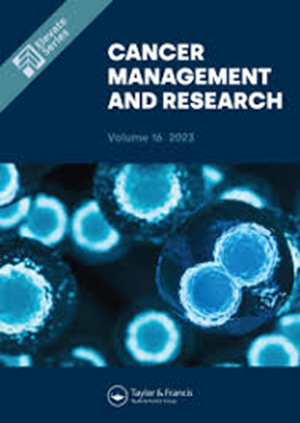将阿特珠单抗、科比美替尼和维莫非尼联用作为 BRAF V600 突变阳性黑色素瘤的治疗方案:患者选择与展望
IF 2.5
4区 医学
Q3 ONCOLOGY
引用次数: 0
摘要
摘要:近年来,随着免疫检查点抑制剂和靶向疗法等新型治疗方案的出现,晚期和转移性黑色素瘤的治疗形势发生了巨大变化,与传统方法相比,这些治疗方案疗效显著,患者预后明显改善。约 50% 的黑色素瘤携带活化 BRAF 基因突变,其中 90% 以上是 BRAF V600E 基因突变。接受 BRAF 抑制剂单药治疗的肿瘤在 6 个月内产生耐药性的比例很高。与 MEK 抑制剂联合治疗有助于缓解这种耐药性,并改善治疗效果。由于在接受 BRAF/MEK 抑制剂治疗的肿瘤中,PD-1/PD-L1 受体上调,进一步的研究纳入了第三种联合用药--抗 PD-1/PD-L1 抑制剂。与单药或双药治疗方案相比,这种三联疗法可能具有更优越的疗效和可控的安全性。白话摘要:有效治疗晚期和转移性黑色素瘤是一项挑战。针对BRAF突变肿瘤患者的新治疗方法包括具有不同互补机制的药物组合。这些药物包括BRAF抑制剂、MEK抑制剂和PD-1/PD-L1抑制剂。与只同时使用其中一种或两种药物相比,这三种药物联合使用时,患者的反应率和生存率可能会更高。三联用药方案的毒性率较高,因此必须考虑谨慎选择患者:BRAF抑制剂 MEK抑制剂 转移性黑色素瘤 BRAF突变黑色素瘤 BRAF联合疗法 三联疗法本文章由计算机程序翻译,如有差异,请以英文原文为准。
Combination Atezolizumab, Cobimetinib, and Vemurafenib as a Treatment Option in BRAF V600 Mutation–Positive Melanoma: Patient Selection and Perspectives
Abstract: The treatment landscape for advanced and metastatic melanoma has drastically changed in recent years, with the advent of novel therapeutic options such as immune checkpoint inhibitors and targeted therapies offering remarkable efficacy and significantly improved patient outcomes compared to traditional approaches. Approximately 50% of melanomas harbor activating BRAF mutations, with over 90% resulting in BRAF V600E. Tumors treated with BRAF inhibitor monotherapy have a high rate of developing resistance within six months. Combination therapy with MEK inhibitors helped to mitigate this treatment resistance and led to improved outcomes. Due to the up-regulation of PD-1/PD-L1 receptors in tumors treated with BRAF/MEK inhibitor therapy, further studies included a third combination agent, anti-PD-1/PD-L1 inhibitors. This triple combination therapy may have superior efficacy and a manageable safety profile when compared with single or double agent therapy regimens.
Plain Language Summary: Effective treatment of advanced and metastatic melanoma can be challenging. Newer treatment methods for patients with BRAF-mutated tumors include a combination of drugs with different complementary mechanisms. These drugs include BRAF-inhibitors, MEK-inhibitors, and PD-1/PD-L1 inhibitors. When these three medications are used in combination, patients may have better response rates and survival outcomes, when compared to using just one or two of these medications together. Toxicity rates are higher with a triple-medication regimen, so careful patient selection is important to consider.
Keywords: BRAF inhibitor, MEK inhibitor, metastatic melanoma, BRAF-mutant melanoma, combination BRAF therapy, triple therapy
Plain Language Summary: Effective treatment of advanced and metastatic melanoma can be challenging. Newer treatment methods for patients with BRAF-mutated tumors include a combination of drugs with different complementary mechanisms. These drugs include BRAF-inhibitors, MEK-inhibitors, and PD-1/PD-L1 inhibitors. When these three medications are used in combination, patients may have better response rates and survival outcomes, when compared to using just one or two of these medications together. Toxicity rates are higher with a triple-medication regimen, so careful patient selection is important to consider.
Keywords: BRAF inhibitor, MEK inhibitor, metastatic melanoma, BRAF-mutant melanoma, combination BRAF therapy, triple therapy
求助全文
通过发布文献求助,成功后即可免费获取论文全文。
去求助
来源期刊

Cancer Management and Research
Medicine-Oncology
CiteScore
7.40
自引率
0.00%
发文量
448
审稿时长
16 weeks
期刊介绍:
Cancer Management and Research is an international, peer reviewed, open access journal focusing on cancer research and the optimal use of preventative and integrated treatment interventions to achieve improved outcomes, enhanced survival, and quality of life for cancer patients. Specific topics covered in the journal include:
◦Epidemiology, detection and screening
◦Cellular research and biomarkers
◦Identification of biotargets and agents with novel mechanisms of action
◦Optimal clinical use of existing anticancer agents, including combination therapies
◦Radiation and surgery
◦Palliative care
◦Patient adherence, quality of life, satisfaction
The journal welcomes submitted papers covering original research, basic science, clinical & epidemiological studies, reviews & evaluations, guidelines, expert opinion and commentary, and case series that shed novel insights on a disease or disease subtype.
 求助内容:
求助内容: 应助结果提醒方式:
应助结果提醒方式:


